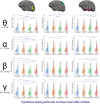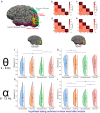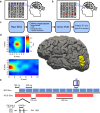Transcranial focused ultrasound to V5 enhances human visual motion brain-computer interface by modulating feature-based attention
- PMID: 38862476
- PMCID: PMC11167030
- DOI: 10.1038/s41467-024-48576-8
Transcranial focused ultrasound to V5 enhances human visual motion brain-computer interface by modulating feature-based attention
Abstract
A brain-computer interface (BCI) enables users to control devices with their minds. Despite advancements, non-invasive BCIs still exhibit high error rates, prompting investigation into the potential reduction through concurrent targeted neuromodulation. Transcranial focused ultrasound (tFUS) is an emerging non-invasive neuromodulation technology with high spatiotemporal precision. This study examines whether tFUS neuromodulation can improve BCI outcomes, and explores the underlying mechanism of action using high-density electroencephalography (EEG) source imaging (ESI). As a result, V5-targeted tFUS significantly reduced the error in a BCI speller task. Source analyses revealed a significantly increase in theta and alpha activities in the tFUS condition at both V5 and downstream in the dorsal visual processing pathway. Correlation analysis indicated that the connection within the dorsal processing pathway was preserved during tFUS stimulation, while the ventral connection was weakened. These findings suggest that V5-targeted tFUS enhances feature-based attention to visual motion.
© 2024. The Author(s).
Conflict of interest statement
B.H. and K.Y. are co-inventors of a pending US patent application (Applicant: Carnegie Mellon University; Inventors: Bin He and Kai Yu; Application No: 18/553,901; Status: Pending; Specific aspect: tFUS and electrophysiological source imaging). J.K. and C.L. have no competing interests to declare.
Figures






Update of
-
Transcranial Focused Ultrasound to V5 Enhances Human Visual Motion Brain-Computer Interface by Modulating Feature-Based Attention.bioRxiv [Preprint]. 2023 Sep 5:2023.09.04.556252. doi: 10.1101/2023.09.04.556252. bioRxiv. 2023. Update in: Nat Commun. 2024 Jun 11;15(1):4382. doi: 10.1038/s41467-024-48576-8. PMID: 37732253 Free PMC article. Updated. Preprint.
References
-
- Harvey EN. The effect of high frequency sound waves on heart muscle and other irritable tissues. Am. J. Physiol. Leg. Content. 1929;91:284–290. doi: 10.1152/ajplegacy.1929.91.1.284. - DOI
MeSH terms
Grants and funding
- U18 EB029354/EB/NIBIB NIH HHS/United States
- DGE2140739/National Science Foundation (NSF)
- R01NS124564, RF1NS131069, R01NS096761, and NS127849/U.S. Department of Health & Human Services | NIH | National Institute of Neurological Disorders and Stroke (NINDS)
- R01 AT009263/AT/NCCIH NIH HHS/United States
- R01 NS124564/NS/NINDS NIH HHS/United States
- T32 EB029365/EB/NIBIB NIH HHS/United States
- R01AT009263/U.S. Department of Health & Human Services | NIH | National Center for Complementary and Integrative Health (NCCIH)
- RF1 NS131069/NS/NINDS NIH HHS/United States
- T32EB029365/U.S. Department of Health & Human Services | NIH | National Institute of Biomedical Imaging and Bioengineering (NIBIB)
- R01 NS127849/NS/NINDS NIH HHS/United States
- R01 NS096761/NS/NINDS NIH HHS/United States
- U18EB029354, T32EB029365/U.S. Department of Health & Human Services | NIH | National Institute of Biomedical Imaging and Bioengineering (NIBIB)
LinkOut - more resources
Full Text Sources
Research Materials

